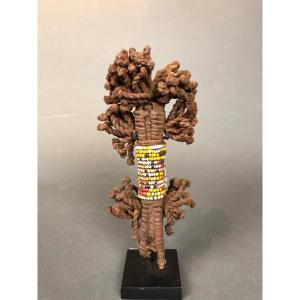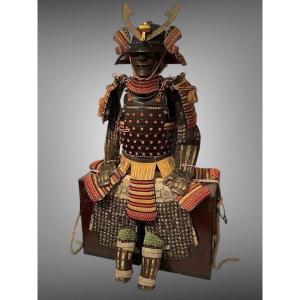YOSHITSUNE-KOTE DO-MARU ARMOR Late Edo period Bakumatsu 1853-1868
This fine quality armor is in the restoration style initiated by the eighth shogun, Tokugawa Yoshimune (1684-1751), who advocated a return to the samurai virtues of the Kamakura period (1185-1333). Typical orange color of the late Edo period: Baku Matsu »
Kabuto (helmet)suji bashi in natural iron with 32 blades With 4 Shiten no Byo (attachment system for the front helmet retaining cord The appearance of ukebari Manju Shikoro (round neck cover) with three slats in Hon kozane which curves in fukigaeshi covered with studded printed suede
dragonfly shaped maedate
Menpo (face mask) in natural iron with a yodarekake (gorget) Nodowa in Hon kozane (individual scales in lacquered iron Do maru do [breastplate
] Dô: Type of do in one part closing on the side, Orange laced in hon-kozane [individual scales],
old style o-sode [large shoulder pads], '
Yoshitsune-kote' [sleeves in the style of the National Treasure kote from the Kasuga Shrine Collection],
The yoshitsune gote is named after the great tragic hero Minamoto no Yoshitsune, who is said to have worn the kote like them. They are marked by a single plate on the forearm, a single plate on the upper arm, an angled disc, and a D-shaped tekkō. This is an older pattern typical of the 11th century. In the 1500s he was in disgrace Golden ironwork on the main openwork components and chiselled peonies among the foliage motif corresponding to that of the 'Yoshitsune-gote',chiselled butterfly and pivoines
multi-sided kusazuri in hon kozane[skirt], iyo-haidate [thigh protector] in orange laced hon kozane
shino sune-ate[shin guards with eleven splints in gold lacquered iron
Bearskin shoes with my gold mon under the sole
Most of the existing Japanese armor outside shrines, temples, museums, and large clan collections dates from the Edo period (1604 - 1868). Few pieces of O-yoroi (the "great harness") made for mounted samurai of the Heian and Kamakura periods survive, although there are a number of Muromachi period armor designed for use on foot. After the Battle of Sekigahara (1600), the Osaka Castle Campaigns (1614 and 1615), and the Shimabara Rebellion of 1637-1638, the armor was not to be used in battle again until the disruption of the Bakumatsu leading to the Meiji Imperial Restoration. of 1867. During these two and a half centuries, armor became primarily an object of display and a luxurious symbol of the power of the samurai class. During the last of the 16th century civil wars, three main types of armor were used, defined by the construction of the do or cuirass. The domaru fitted around the body and closed on the right side(like jere)
; the haramaki mounted on the shoulders in front and with the joint in the back and the nimai-do was in two front and rear sections joined by a vertical hinge on the left side. Of these, early domaru and haramaki were composed of rows of kozane, individual scales of lacquered iron and leather laced together in horizontal rows. The haramaki had a separate piece, the seita (back plate) to cover the joint, which was sometimes
wickedly called okubyo-ita [the coward's plate] on the grounds that one should never turn one's back towards the enemy.
The nimai-do which was in fact sometimes composed of a greater number of pieces forming two main parts, seems to derive from European armours, which had separate front and back pieces. After the matchlock rifle appeared on the battlefields of Japan in the middle of the 15th century, the cuirass of the nimai-do in particular was reinforced, and sometimes made of a solid iron plate that was more resistant to bullets. The nimaido became popular in the 16th century in place of the older O-yoroi, domaru, and haramaki for its advantages in infantry combat which was prevalent at the time. Armor with nimai-do and smaller components covering most of the body was preferred by even the most traditional of daimyo (provincial samurai lords). These armors were less complex to make and therefore less expensive than the older style of hundreds of individual laced scales, and the helmets were also simpler in construction, sometimes having only a few plates.
"Tosei Gusoku", Such armor was known as Tosei Gusoku or "Equipment of the Age", indicating that it had come into fashion. But although simple in construction, tosei gusoku were sometimes decorated in eccentric styles, with exotically shaped helmets. Even after the onset of peace in the Edo period, many daimyo continued to wear the utilitarian tosei gusoku during ceremonies due to its association with remembrance of the wars of a generation or two ago. But for some, the older, rather taller yoroi with a large expansive shikoro [neck guard], sode [shoulder guards] and a traditional helmet made up of many plates with large kuwagata [stylized horns] were considered more suitable for high-ranking samurai. These are the domaru and haramaki The construction of these more luxurious armors is mainly of tightly laced individual scales kebiki odoshi honkozane], in which small scales of iron or leather are laced together in rows, the scales lacquered and several rows laced together to form the various components of the 'armor.Passer directement au contenu principalAide sur l'accessibilité
After Tokugawa Ieyasu's death in 1616, his armor, a black lacquered tosei gusoku with the cloth cap-like helmet of the folk deity Daikoku-Ten, was enshrined in Kunozan Toshogu Shrine, where the spirits of Ieyasu, and Oda Nobunaga are revered. This armor was reproduced by the successor of Ieyasu, then for each generation of the Tokugawa house until the end of the Edo period.
The custom was thus born that each daimyo during his succession would have an armor made by copying that of his father, or of the previous generation. This custom was already well established in Shinto shrines, and even to this day the Grand Shrine of Ise, dedicated to the Divinity of the Sun, is rebuilt, and its treasures refurbished, every twenty years in a practice that dates back to the less as far back to Nara times. It is largely thanks to this activity that traditional craftsmanship has been maintained through the centuries in Japan. Indeed, Japanese armor itself has been the nurturer of several traditions, because its manufacture involves close collaboration between ironworkers, sculptors and gilders of soft metals, leatherworkers, lacquerers, dyers and silk embroiderers, kumihimo makers, or silk braid, all under the direction of the armourer. After Tokugawa Ieyasu's death in 1616, his armor, a black lacquered tosei gusoku with the cloth cap-like helmet of the folk deity Daikoku-Ten, was enshrined in Kunozan Toshogu Shrine, where the spirits of Ieyasu, and Oda Nobunaga are revered. This armor was reproduced by the successor of Ieyasu, then for each generation of the Tokugawa house until the end of the Edo period. The custom was thus born that each daimyo during his succession would have an armor made by copying that of his father, or of the previous generation. This custom was already well established in Shinto shrines, and even to this day the Grand Shrine of Ise, dedicated to the Divinity of the Sun, is rebuilt, and its treasures refurbished, every twenty years in a practice that dates back to the less as far back to Nara times. It is largely thanks to this activity that traditional craftsmanship has been maintained through the centuries in Japan
The custom was thus born that each daimyo during his succession would have an armor made by copying that of his father, or of the previous generation. This custom was already well established in Shinto shrines, and even to this day the Grand Shrine of Ise, dedicated to the Divinity of the Sun, is rebuilt, and its treasures refurbished, every twenty years in a practice that dates back to the less as far back to Nara times. It is largely thanks to this activity that traditional craftsmanship has been maintained through the centuries in Japan. We liked to salvage the bowl from ancient helmets. Early helmets were not always readily available, and Edo period gunsmiths changed with newer pieces or made helmets in the archaic style. Other armors incorporated copies of works from the Heian or Kamakura period, such as the so-called Yoshitsune-gote based on the original national treasure pair of sleeves kept in Kasuga Grand Shrine, Nara. Although they belonged to the hero of the Heian period, Minamoto-no-Yoshitsune, the scabbards actually date from the Kamakura period, but are none the less one of the finest examples of the art of the gunsmith. The fashion for old-style armor was firmly established when the Eighth Shogun Ieyoshi (1684 - 1750) promoted a revival of ancient weapons, including swords and armor, to revitalize what he believed to be a decline in martial spirit of the nation. Since armor of this quality made in the Edo period would probably cost the equivalent of a house today During the Edo period, there were about 260 daimyo each occupying an estate with a castle and a mansion, and guarding a secondary mansion in the capital, Edo (now Tokyo). The Tokugawas made it obligatory for each daimyo to spend six months or a year (depending on his hereditary allegiance to Sekigahara) at his Edo mansion, and to leave his wife and heir there when he returned to his domain each year. 'origin. This system, then called sankin kotai, was instituted to prevent the possibility of an insurrection and to keep the provincial samurai busy.
The requirement was that the daimyo travel with a large retinue, ranging from a few hundred to over one or two thousand for a wealthier daimyo like the Maeda of Kaga Province. Armor could be worn at certain stages of the journey, but it was mostly symbolic, as there was no possibility that a procession of daimyo would ever attack Edo. It was customary for armor to be produced as an ancestral relic for display on certain days of the year, such as tango no sekku every May 5, which became known as "Boys Day". When not in use, the armor was stored in its box, thus preserving it from insect attack and keeping its natural folds intact. In this respect the similarity to the silk kimono, which is folded when not in use and hung in its natural folds when displayed in a museum or gallery, is obvious, perhaps an indication of the Japanese respect for objects by allowing them their own place. and existence. The last time traditional Japanese armor was worn in anger was during the failed Seinan no Eki, or samurai's "Satsuma Rebellion" against the Meiji government in 1877. The Last Samurai Fell under gunfire and armor became a symbol of the times. in which peace had once been maintained by the display of arms. Japanese armor remains today what it had become during the Edo period - a symbol of ancient military virtue and an object of luxurious beauty.






























 Le Magazine de PROANTIC
Le Magazine de PROANTIC TRÉSORS Magazine
TRÉSORS Magazine Rivista Artiquariato
Rivista Artiquariato
